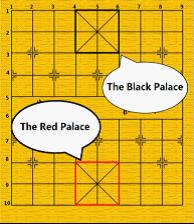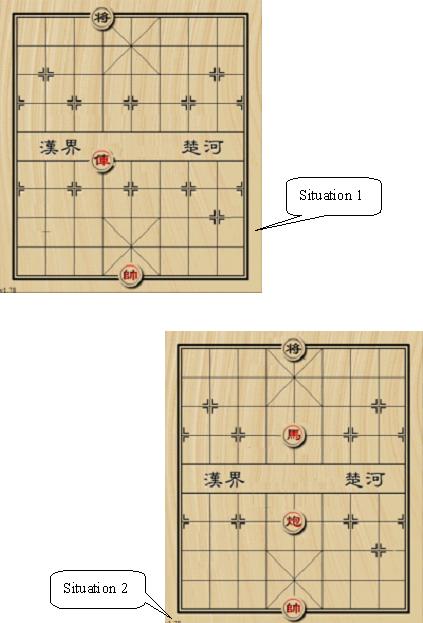HDU 4121 Xiangqi 我老了?
Xiangqi
Time Limit: 2000/1000 MS (Java/Others) Memory Limit: 32768/32768 K (Java/Others)
Total Submission(s): 3193 Accepted Submission(s): 780
Now we introduce some basic rules of Xiangqi. Xiangqi is played on a 10×9 board and the pieces are placed on the intersections (points). The top left point is (1,1) and the bottom right point is (10,9). There are two groups of pieces marked by black or red Chinese characters, belonging to the two players separately. During the game, each player in turn moves one piece from the point it occupies to another point. No two pieces can occupy the same point at the same time. A piece can be moved onto a point occupied by an enemy piece, in which case the enemy piece is "captured" and removed from the board. When the general is in danger of being captured by the enemy player on the enemy player’s next move, the enemy player is said to have "delivered a check". If the general's player can make no move to prevent the general's capture by next enemy move, the situation is called “checkmate”.
We only use 4 kinds of pieces introducing as follows: General: the generals can move and capture one point either vertically or horizontally and cannot leave the “palace” unless the situation called “flying general” (see the figure above). “Flying general” means that one general can “fly” across the board to capture the enemy general if they stand on the same line without intervening pieces.
General: the generals can move and capture one point either vertically or horizontally and cannot leave the “palace” unless the situation called “flying general” (see the figure above). “Flying general” means that one general can “fly” across the board to capture the enemy general if they stand on the same line without intervening pieces. Chariot: the chariots can move and capture vertically and horizontally by any distance, but may not jump over intervening pieces
Chariot: the chariots can move and capture vertically and horizontally by any distance, but may not jump over intervening pieces Cannon: the cannons move like the chariots, horizontally and vertically, but capture by jumping exactly one piece (whether it is friendly or enemy) over to its target.
Cannon: the cannons move like the chariots, horizontally and vertically, but capture by jumping exactly one piece (whether it is friendly or enemy) over to its target. Horse: the horses have 8 kinds of jumps to move and capture shown in the left figure. However, if there is any pieces lying on a point away from the horse horizontally or vertically it cannot move or capture in that direction (see the figure below), which is called “hobbling the horse’s leg”.
Horse: the horses have 8 kinds of jumps to move and capture shown in the left figure. However, if there is any pieces lying on a point away from the horse horizontally or vertically it cannot move or capture in that direction (see the figure below), which is called “hobbling the horse’s leg”.

Now you are given a situation only containing a black general, a red general and several red chariots, cannons and horses, and the red side has delivered a check. Now it turns to black side’s move. Your job is to determine that whether this situation is “checkmate”.
There is a blank line between two test cases. The input ends by 0 0 0.
G 10 5
R 6 4
3 1 5
H 4 5
G 10 5
C 7 5
0 0 0
NO

In the first situation, the black general is checked by chariot and “flying general”.
In the second situation, the black general can move to (1, 4) or (1, 6) to stop check.
See the figure above.

#include <iostream>
#include <stdio.h>
#include <string>
#include <string.h>
#include <algorithm>
#include <stdlib.h>
#include <math.h>
#include <vector>
#include <map>
using namespace std;
int d[][]={{,},{-,},{,},{,-}};
struct Node{
int x;
int y;
char ch;
}node[];
char grid[][];
int n;
bool put[][];
bool cango(int x,int y){
if(x<||x>||y<||y>)
return ;
return ;
}
bool judge(int x,int y){
int i,j,xx,yy;
for(i=;i<=n;i++){
if(node[i].x==x&&node[i].y==y)
continue;
if(node[i].ch=='R'||node[i].ch=='G'){
for(j=;j<;j++){
xx=node[i].x+d[j][];
yy=node[i].y+d[j][];
while(cango(xx,yy)&&put[xx][yy]==){
if(xx==x&&yy==y)
return ;
xx+=d[j][];
yy+=d[j][];
}
}
}
else if(node[i].ch=='C'){
for(j=;j<;j++){
xx=node[i].x+d[j][];
yy=node[i].y+d[j][];
while(cango(xx,yy)&&put[xx][yy]==){
xx+=d[j][];
yy+=d[j][];
}
xx+=d[j][];
yy+=d[j][];
while(cango(xx,yy)&&put[xx][yy]==){
if(xx==x&&yy==y)
return ;
xx+=d[j][];
yy+=d[j][];
}
}
}
else if(node[i].ch=='H'){
int X=node[i].x ,h_x;
int Y=node[i].y ,h_y;
if(cango(X-,Y)&&put[X-][Y]==){
h_x=X-;
h_y=Y+;
if(cango(h_x,h_y)&&put[h_x][h_y]==){
if(h_x==x&&h_y==y)
return ;
}
h_x=X-;
h_y=Y-;
if(cango(h_x,h_y)&&put[h_x][h_y]==){
if(h_x==x&&h_y==y)
return ;
}
}
if(cango(X+,Y)&&put[X+][Y]==){
h_x=X+;
h_y=Y+;
if(cango(h_x,h_y)&&put[h_x][h_y]==){
if(h_x==x&&h_y==y)
return ;
}
h_x=X+;
h_y=Y-;
if(cango(h_x,h_y)&&put[h_x][h_y]==){
if(h_x==x&&h_y==y)
return ;
}
} if(cango(X,Y-)&&put[X][Y-]==){
h_x=X+;
h_y=Y-;
if(cango(h_x,h_y)&&put[h_x][h_y]==){
if(h_x==x&&h_y==y)
return ;
}
h_x=X-;
h_y=Y-;
if(cango(h_x,h_y)&&put[h_x][h_y]==){
if(h_x==x&&h_y==y)
return ;
}
} if(cango(X,Y+)&&put[X][Y+]==){
h_x=X+;
h_y=Y+;
if(cango(h_x,h_y)&&put[h_x][h_y]==){
if(h_x==x&&h_y==y)
return ;
}
h_x=X-;
h_y=Y+;
if(cango(h_x,h_y)&&put[h_x][h_y]==){
if(h_x==x&&h_y==y)
return ;
}
}
}
}
return ;
}
int main(){
int ch,i,j,xx,yy,x,y,flag,sum,f;
while(scanf("%d%d%d",&n,&x,&y)){
if(n==&&x==&&y==)
break;
memset(put,,sizeof(put));
for(i=;i<=;i++)
for(j=;j<=;j++)
grid[i][j]='#';
for(i=;i<=n;i++){
cin>>node[i].ch>>node[i].x>>node[i].y;
put[node[i].x][node[i].y]=;
grid[node[i].x][node[i].y]=node[i].ch;
}
f=;
xx=x;
yy=y;
while(cango(xx,yy)){
xx+=;
if(grid[xx][yy]=='G'){
f=;
}
else if(grid[xx][yy]!='#')
break;
}
if(f){
printf("NO\n");
continue;
}
sum=flag=;
for(i=;i<;i++){
xx=x+d[i][];
yy=y+d[i][];
if(xx>=&&xx<=&&yy>=&&yy<=){
sum++;
put[xx][yy]=;
if(judge(xx,yy))
flag++;
if(grid[xx][yy]!='#')
put[xx][yy]=;
}
}
//printf("sum %d flag %d\n",sum,flag);
if(flag==sum)
printf("YES\n");
else
printf("NO\n");
}
return ;
}
13年

#include <iostream>
#include <string>
#include <string.h>
#include <map>
#include <stdio.h>
#include <algorithm>
#include <queue>
#include <vector>
#include <math.h>
#include <set>
#define Max(a,b) ((a)>(b)?(a):(b))
#define Min(a,b) ((a)<(b)?(a):(b))
#pragma comment(linker, "/STACK:16777216")
using namespace std ;
typedef long long LL ;
struct Point{ /*坐标点*/
int X ;
int Y ;
Point(){} ;
Point(int x,int y):X(x),Y(y){} ;
}; struct Chess{ /*棋子数据*/
string S ;
Point P ;
Chess(){} ;
Chess(string s ,Point p):S(s),P(p){} ;
}; class Man{ /*玩家*/
private :
static int d_horse[][] ;
static int d_obstacle[][] ;
int N ;
int black_x ,black_y ;
bool grid[][] ;
vector<Chess> Genaral_Or_Che_Pao ; //将 or 车 or 炮
vector<Chess> Horse ; //马
public :
Man() ;
void read(vector<Chess> ,int ,int) ;
int cango(int,int) ;
int ok_genaral_or_che_pao() ;
int ok_horse() ;
int win() ; //是否必胜
}; int Man::d_horse[][]={{-,-},{-,},{-,},{,},
{,-},{,},{-,-},{,-} } ; int Man::d_obstacle[][]={{-,},{,},{,},{,-}}; Man::Man(){ } int Man::cango(int x ,int y){
return <= x && x<= && <= y && y <= ;
} void Man::read(vector<Chess> chess,int b_x ,int b_y){
black_x = b_x ;
black_y = b_y ;
memset(grid,,sizeof(grid)) ;
Genaral_Or_Che_Pao.clear() ;
grid[black_x][black_y] = ;
string s ;
int x ,y ;
for(int i = ;i < chess.size() ;i++){
s = chess[i].S ;
x = chess[i].P.X ;
y = chess[i].P.Y ;
if(x == black_x && y == black_y)
continue ;
grid[x][y] = ;
if(s == "H")
Horse.push_back(chess[i]) ;
else
Genaral_Or_Che_Pao.push_back(chess[i]) ;
}
} int Man::ok_genaral_or_che_pao(){
int x ,y ,L ,R ,k;
string s ;
for(int i = ;i < Genaral_Or_Che_Pao.size() ;i++){
x = Genaral_Or_Che_Pao[i].P.X ;
y = Genaral_Or_Che_Pao[i].P.Y ;
s = Genaral_Or_Che_Pao[i].S ;
if(x == black_x){
L = Min(y ,black_y) + ;
R = Max(y ,black_y) - ;
int dot = ;
for(k = L ;k <= R ;k++)
dot += grid[x][k] ;
if(dot == && s == "C")
return ;
if(dot == && s!= "C")
return ;
}
if(y == black_y){
L = Min(x ,black_x) + ;
R = Max(x ,black_x) - ;
int dot = ;
for(k = L ;k <= R ;k++)
dot += grid[k][y] ;
if(dot == && s == "C")
return ;
if(dot == && s!= "C")
return ;
}
}
return ;
} int Man::ok_horse(){
int x ,y ,k ,x2 ,y2 ,x1,y1;
for(int i = ;i < Horse.size() ;i++){
x = Horse[i].P.X ;
y = Horse[i].P.Y ;
for(k = ;k < ;k++){
x2 = d_horse[k][] + x ;
y2 = d_horse[k][] + y ;
x1 = d_obstacle[k>>][] + x ;
y1 = d_obstacle[k>>][] + y ;
if(!cango(x2,y2)||!cango(x1,y1))
continue ;
if(!grid[x1][y1] && black_x == x2 && black_y == y2)
return ;
}
}
return ;
} int Man::win(){
if(ok_genaral_or_che_pao())
return ;
if(ok_horse())
return ;
return ;
} class App{
private :
vector<Chess> chess ;
bool mat[][] ;
static int d[][] ;
int N ;
int black_x ;
int black_y ;
int red_x ;
int red_y ;
public :
App(){};
App(int ,int ,int) ;
int cango(int ,int) ;
int judge() ;
void read() ;
}; App::App(int n ,int x , int y):N(n),black_x(x),black_y(y){
chess.clear() ;
memset(mat,,sizeof(mat)) ;
}; int App::d[][]={{,},{-,},{,-},{,}} ; int App::cango(int x ,int y){
return <= x && x<= && <= y && y<= ;
} void App::read(){
chess.clear() ;
string s ;
int x ,y ;
for(int i = ;i <= N ;i++){
cin>>s>>x>>y ;
mat[x][y] = ;
chess.push_back(Chess(s,Point(x,y))) ;
if(s == "G"){
red_x = x ;
red_y = y ;
}
}
} int App::judge(){
if(black_y == red_y){ //黑方 将 直接 干死 红方 将
int dot = ;
for(int i = black_x + ;i <= red_x- ;i++)
dot += mat[i][red_y] ;
if(dot == )
return ;
}
int sum = ;
for(int i = ; i < ;i++){ //黑方 将 四个方向逃跑
int x = black_x + d[i][] ;
int y = black_y + d[i][] ;
if(!cango(x,y))
continue ;
Man red ;
red.read(chess,x,y) ; //传递数据,(x,y)为此时黑方的将
if(!red.win()) //只要红方不能赢 则不是 死局
return ;
}
return ;
} int main(){
int n ,x, y;
while(cin>>n>>x>>y){
if(n==&&x==&&y==)
break ;
App app(n,x,y) ;
app.read() ;
if(app.judge())
puts("NO") ;
else
puts("YES") ;
}
return ;
}
SR~046NDV.jpg)
HDU 4121 Xiangqi 我老了?的更多相关文章
- HDU 4121 Xiangqi 模拟题
Xiangqi Time Limit: 20 Sec Memory Limit: 256 MB 题目连接 http://acm.hdu.edu.cn/showproblem.php?pid=4121 ...
- HDU 4121 Xiangqi (算是模拟吧)
传送门:http://acm.hdu.edu.cn/showproblem.php?pid=4121 题意:中国象棋对决,黑棋只有一个将,红棋有一个帅和不定个车 马 炮冰给定位置,这时当黑棋走,问你黑 ...
- HDU 4121 Xiangqi --模拟
题意: 给一个象棋局势,问黑棋是否死棋了,黑棋只有一个将,红棋可能有2~7个棋,分别可能是车,马,炮以及帅. 解法: 开始写法是对每个棋子,都处理处他能吃的地方,赋为-1,然后判断将能不能走到非-1的 ...
- HDU 4121 Xiangqi
模拟吧,算是... 被这个题wa到哭,真是什么都不想说了...上代码 #include <iostream> #include <cstring> using namespac ...
- HDU 4121
http://www.bnuoj.com/v3/problem_show.php?pid=10277 //#pragma comment(linker, "/STACK:16777216&q ...
- HDU 4461:The Power of Xiangqi(水题)
http://acm.hdu.edu.cn/showproblem.php?pid=4461 题意:每个棋子有一个权值,给出红方的棋子情况,黑方的棋子情况,问谁能赢. 思路:注意“ if a play ...
- HDU 4461 The Power of Xiangqi (水题)
题意:给定一些字母,每个字母都代表一值,如果字母中没有B,或者C,那么就在总值大于1的条件下删除1,然后比较大小. 析:没什么好说的,加起来比较就好了. 代码如下: #pragma comment(l ...
- *HDU 2108 计算几何
Shape of HDU Time Limit: 3000/1000 MS (Java/Others) Memory Limit: 32768/32768 K (Java/Others)Tota ...
- hdu 1010 深搜+剪枝
深度搜索 剪枝 还不是很理解 贴上众神代码 //http://blog.csdn.net/vsooda/article/details/7884772#include<iostream> ...
随机推荐
- smarty函数
内置函数(重要的几个): <{html_checkboxes name='nation' values=$code output=$name selected=$selid separator= ...
- smarty变量
前台: 注释的两种方式:<{**}>和<!--注释html代码-->比如: <{* <div style="width:100px; height:100 ...
- 【转】Java集合框架综述
文章目录 1. 集合框架(collections framework) 2. 设计理念 3. 两大基类Collection与Map 3.1. Collection 3.2. Map 4. 集合的实现( ...
- poj2352消防站
题目大意:有n个点的一棵树,每个点有两个值:w和c.现在要在其中若干点建立消防站,使得每个点到最近的消防站的距离不超过该点的c值,i点建立消防站的费用为w.求最小费用. 分析:本题显然是树型Dp.定义 ...
- linux内核模块相关命令:lsmod,depmod,modprobe,modinfo,insmod,rmmod 使用说明
加载内核驱动的通常流程: 1.先将.ko文件拷贝到/lib/module/`uname -r`(内核版本号)/kernel/driver/...目录下, 根据具体用途的区别分为net.ide.scsi ...
- activiti自定义流程之Spring整合activiti-modeler5.16实例(七):任务列表展示
注:(1)环境搭建:activiti自定义流程之Spring整合activiti-modeler5.16实例(一):环境搭建 (2)创建流程模型:activiti自定义流程之Spring ...
- “代理 XP”组件已作为此服务器安全配置的一部分被关闭。解决方法
新建维护计划的时候遇到下图的报错信息 标题: Microsoft SQL Server Management Studio------------------------------ “代理 XP”组 ...
- Android Gradle实用技巧——多渠道打包
友盟有很多不错的功能,例如渠道统计等. 想要做渠道统计,有一个要求就是要在manifest文件中添加各个渠道的配置.只有一两个渠道还好说,但是渠道多了的话,手动修改然后打包简直是噩梦. 幸好现在And ...
- MarkDowdPad 破解
一部小心把markdown破解了,把破解后的主程序发出来吧,放到安装根目录即可.点击升级到专业,随意输入邮箱和8位注册码,确定后会显示失败,返回即可,然后你就会发现已经变成专业版了. 不知道博客园怎么 ...
- hibernate 大对象映射
1. 在pojo类中 用Blob类和Clob public class Student { private int id; private String name; private int age; ...
